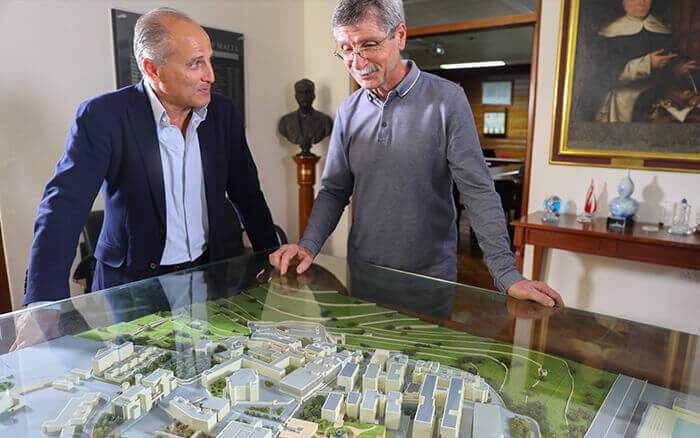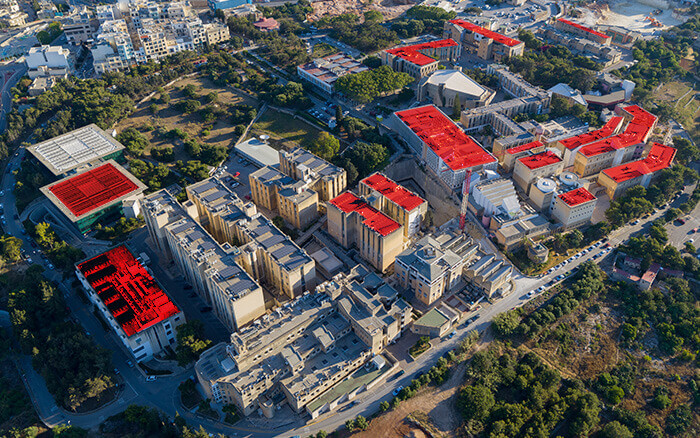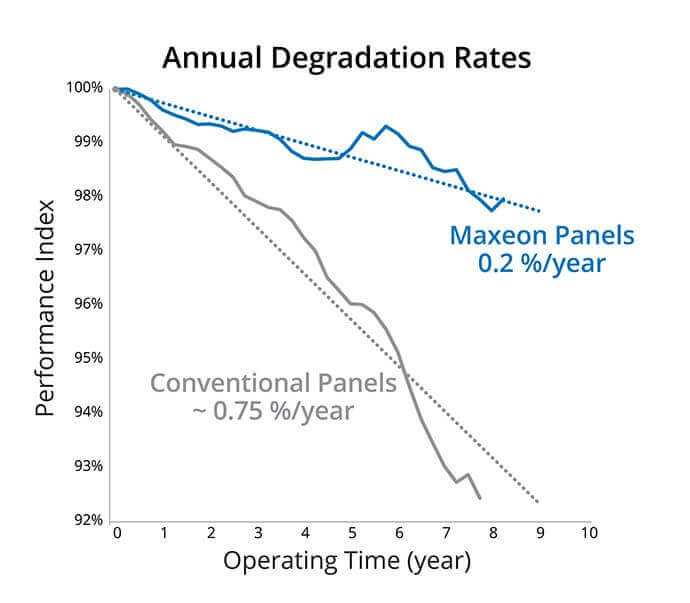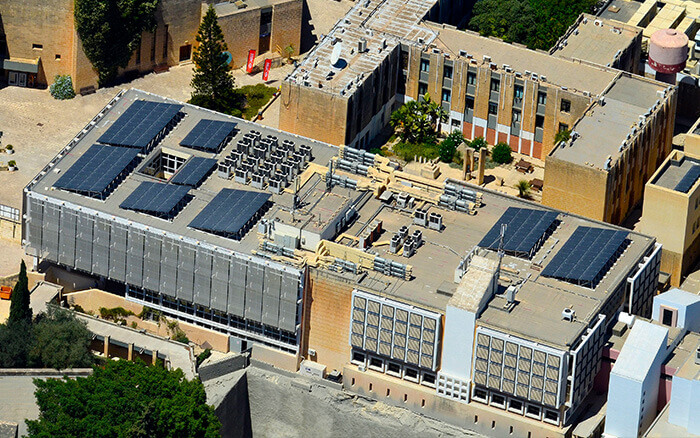
Malta Part 4: The University of Malta Sets Lasting Example for Solar Leadership
An Important Legacy
Universities have an important role to play in the advancement of energy innovation. At the University of Malta, one of the oldest institutions of higher education in the world, being on the cutting edge of sustainability and climate resilience efforts, this means an ambitious plan to power its campuses with solar energy.
For 250 years, the University of Malta has stood at the crossroads of history and progress. Tracing its origins to 1592 when a medical college was established by knights, the University is a melting pot of cultures and ideas, including the very current topic of how best to transition its energy resources to ensure climate resilience.

University of Malta Professor Ing Joseph Micallef reviews campus rooftops with Mario Cachia, CEO of Alternative Technologies – an Authorised SunPower partner in the Maltese Islands.
“The University of Malta is the only university on the island, and therefore, we feel that we should be a role model in sustainability,” explains Ing Joseph Micallef, Professor of Microelectronics & Nanoelectronics at the University of Malta. “As a result, 12 years ago we started an energy management program, which has three prongs: the use of renewable energy, the use of energy efficient equipment, and energy management itself.”
Sustainability is a core tenet of the University’s strategic plan and a clear focus of the Professor’s work as he played a key role in development of the University’s renewable energy transition. Until recently, Malta has been extremely reliant on fossil fuel imports.
“We are using photovoltaic systems in order to generate as much renewable energy as possible for our consumption,” Professor Micallef says. “But the difficulty we have is that the campus area is not very large, and we cannot use ground-mounted PV systems. Therefore we can only use the roofs that we have on campus.”
The University selected SunPower for the project after issuing a public tender that weighed quality, efficiency and reliability as key factors in addition to price. Alternative Technologies Ltd, an Authorised SunPower partner, submitted its offer with SunPower® Maxeon® 3 panels – the highest efficiency1 Based on datasheet review of websites of top 20 manufacturers per IHS, as of May, 2019. and highest reliability2 Jordan, et. al. Robust PV Degradation Methodology and Application. PVSC 2018 panels at the time on the market, backed by the industry’s most comprehensive warranty.3 Based on Jan, 2019 review of warranties on manufacturer websites for top 20 manufacturers per IHS 2018. The tender was awarded to Alternative Technologies for a total of 1,745 SunPower Maxeon solar panels, or more than 600 kilowatts of solar spread over 11 campus buildings. This translates to 16% of the University’s electricity needs leading to an annual reduction of over 2,500 tonnes of carbon emissions.

The University of Malta installed nearly 2,000 SunPower Maxeon solar panels (602kW) on eleven buildings, ten of them pictured here.
Tough Conditions and Tight Roof Space
With limited roof space, choosing the most efficient solar technology was paramount for the University team. Even a percentage point difference in PV system efficiency can translate to thousands of kilowatt hours of production capacity, also impacting financial returns and sustainability.
The challenge of installing rooftop solar in such a constrained space led the University experts developing the solar tender to specify a high-efficiency solar panel that was also highly reliable.
“Our choice of SunPower arises from the fact that we have limited space available, and therefore we wanted to maximize the energy generation in that space,” the Professor notes. “Because SunPower PV panels are much more efficient, of course, that made it a very important choice for us.”
SunPower Maxeon panels also have the industry’s lowest solar panel degradation rate4 Jordan, et al, “Robust PV Degradation Methodology Application” PVSC 2018 and “Compendium of Photovoltaic Degradation Rates” PiP 2016. which means that they deliver more electricity – and consequently more savings – over time. This, combined with SunPower’s industry-leading efficiency, is what allows Maxeon panels to generate 35% more energy from the same space over the first 25 years.5 SunPower 400 W, 22.6% efficient, compared to a Conventional Panel on same-sized arrays (310 W mono PERC, 19% efficient, approx. 1.64 m²)

Submitted to rigorous third-party testing, SunPower Maxeon panels have demonstrated the lowest degradation rate in the solar industry, meaning they retain their power at a higher rate over time.4 Jordan, et al, “Robust PV Degradation Methodology Application” PVSC 2018 and “Compendium of Photovoltaic Degradation Rates” PiP 2016.
The University installed the SunPower systems in 2015 and they have performed consistently ever since: “The PV systems that we have installed using SunPower panels are working very well,” says Professor Micallef. “We have barely had any reduction over the past four years in the output generated by the PV panels.”
Extreme Weather, Hurricane-Force Winds
The Maltese Islands experience extremely high temperatures for at least six months of the year, meaning PV panels must be able to withstand constant heat. Solar panels typically lose some performance in high heat situations.
“We see that the losses that we have in the summer are very contained because of the temperature coefficient that the panels have,” the Professor notes. “We have very little losses because of the specifications that we put in right at the beginning, so we are very happy with the performance.”
Durability in the face of the islands’ constant winds and threat of unprecedented storms was also a concern. In February 2019, Malta was hit with a storm that reportedly was the worst since 1982, with wind gusts reaching a record of 133 kilometers per hour.6 Source: https://timesofmalta.com/articles/view/worst-storm-since-1982-saw-record-gusts-of-133kmh-muscat.702998
The SunPower panels installed at the University of Malta were certified to Cyclonic Load Resistance of over 6400 Pa7 AS/NZS4040.2 and AS/NZS1170.2 per HSEC report E160520 and ACE report 19-0381.02. , equivalent to 375 kilometres per hour8 https://www.eurocodeapplied.com/ , which is above a Category Five on the cyclone intensity scale.9 https://en.wikipedia.org/wiki/Tropical_cyclone_scales
Customers should note that solar systems in high wind areas must be carefully designed by local experts and correctly installed in compliance with local guidelines, regulations and carefully chosen equipment. However, industry experts recommend starting your system design with a high wind-load solar panel as a critical first step.10 https://rmi.org/solar-under-storm-designing-hurricane-resilient-pv-systems/
“The University is at a high point on the island and the rooftop of the library building for example is totally exposed [to the elements] from all angles,” said Mario Cachia, CEO of Alternative Technologies, who designed and installed the system. “We are happy to say that the structure and the panels withstood these weather conditions successfully.”

The library building of the University of Malta, shown in August 2019, is still performing better than expected after enduring Malta’s strongest winds since 1982.
As Malta transitions its energy supply to more renewable sources, the University of Malta’s leadership will have a lasting impact – not just on island residents but on the University students who learn from its example. Change doesn’t always come easily, but when it does, there’s no turning back.
Project Summary
Product: 1,745 Maxeon 3 Solar Panels @34Wp
Project Type: 11 University Building Rooftops
System Size: 602kWp, 944,800 MWh Annually
| Challenge: | Solution: | |
| Limited roof space |
|
|
|
Harsh Environment: High temperatures & strong winds |
|
|